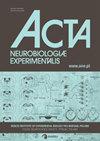Time‑dependent changes in blood cells, NIHSS and mRS according to reperfusion treatment type in stroke patients who developed hemorrhagic complication
IF 1.4
4区 医学
Q4 NEUROSCIENCES
引用次数: 0
Abstract
Hemorrhagic complications may be seen following reperfusion therapy with rtPA and/or thrombectomy after acute ischemic stroke (AIS). Neutrophils, lymphocytes, and platelets have important roles in the inflammatory and immune responses that develop in these patients. We investigated time‑dependent changes in blood cells, NIHSS and mRS values according to type of reperfusion therapy in AIS patients who developed cerebral hemorrhage. In AIS patients who underwent rtPA and/or thrombectomy and developed cerebral hemorrhage within the first 24 hours after treatment, leukocyte, neutrophil, lymphocyte, platelet counts and their ratios were recorded on admission, 1st, 3rd, and 7th days. NIHSS values on admission, 3rd days and mRS values on admission, discharge, and the 3rd month were recorded. These values were compared according to the type of reperfusion therapy. Out of 436 AIS patients, rtPA was applied in 50.5%, thrombectomy in 28.2%, and rtPA+thrombectomy in 21.3%. Hemorrhage developed in 25.5% of the patients. Patients treated with thrombectomy had a greater rate of cerebral hemorrhage. Pre‑stroke mRS values were lower in all therapy types than mRS scores at discharge and the 3rd month. The NIHSS scores did not differ significantly in 3 days. Depending on the type of reperfusion treatment, there are a few time‑dependent significant changes observed in the blood cell counts and ratios. In conclusion, there is a relation between the type of reperfusion therapy and the time‑dependent changes in blood cells and ratios as well as mRS scores among AIS patients who have undergone rtPA and/or thrombectomy and developed cerebral hemorrhage.发生出血性并发症的脑卒中患者的血细胞、NIHSS 和 mRS 随时间变化的再灌注治疗类型
急性缺血性脑卒中(AIS)后使用 rtPA 和/或血栓切除术进行再灌注治疗后,可能会出现出血性并发症。中性粒细胞、淋巴细胞和血小板在这些患者发生的炎症和免疫反应中发挥着重要作用。我们研究了发生脑出血的 AIS 患者的血细胞、NIHSS 和 mRS 值随再灌注治疗类型的时间变化。对接受 rtPA 和/或血栓切除术并在治疗后 24 小时内发生脑出血的 AIS 患者,记录其入院、第 1 天、第 3 天和第 7 天的白细胞、中性粒细胞、淋巴细胞、血小板计数及其比率。记录入院、第 3 天的 NIHSS 值以及入院、出院和第 3 个月的 mRS 值。根据再灌注疗法的类型对这些数值进行比较。在436名AIS患者中,50.5%的患者使用了rtPA,28.2%的患者使用了血栓切除术,21.3%的患者使用了rtPA+血栓切除术。25.5%的患者出现出血。接受血栓切除术治疗的患者脑出血发生率更高。在所有治疗类型中,卒中前的mRS值均低于出院时和第3个月时的mRS评分。3天后的NIHSS评分没有明显差异。根据再灌注治疗的不同类型,在血细胞计数和比率方面观察到一些与时间相关的显著变化。总之,在接受过 rtPA 和/或血栓切除术并出现脑出血的 AIS 患者中,再灌注治疗的类型与血细胞和比率以及 mRS 评分的时间依赖性变化之间存在一定的关系。
本文章由计算机程序翻译,如有差异,请以英文原文为准。
求助全文
约1分钟内获得全文
求助全文
来源期刊
CiteScore
2.20
自引率
7.10%
发文量
40
审稿时长
>12 weeks
期刊介绍:
Acta Neurobiologiae Experimentalis (ISSN: 0065-1400 (print), eISSN: 1689-0035) covers all aspects of neuroscience, from molecular and cellular neurobiology of the nervous system, through cellular and systems electrophysiology, brain imaging, functional and comparative neuroanatomy, development and evolution of the nervous system, behavior and neuropsychology to brain aging and pathology, including neuroinformatics and modeling.

 求助内容:
求助内容: 应助结果提醒方式:
应助结果提醒方式:


